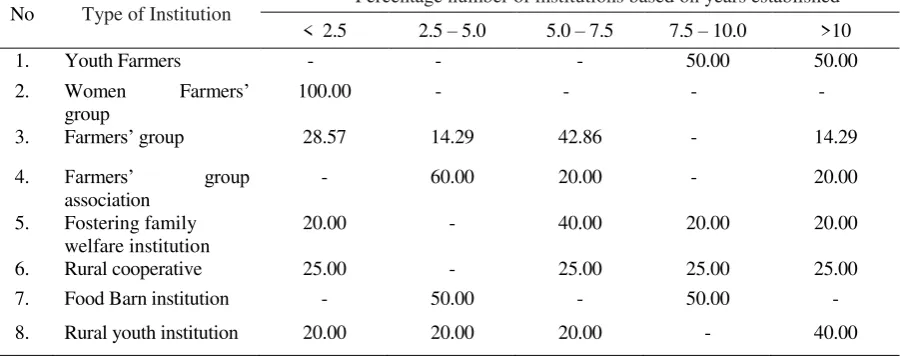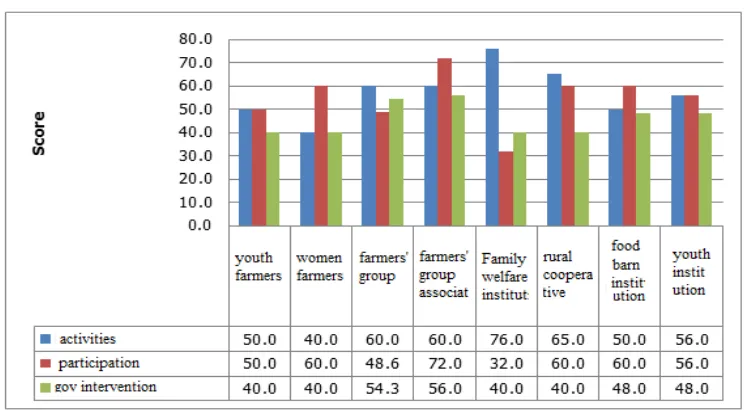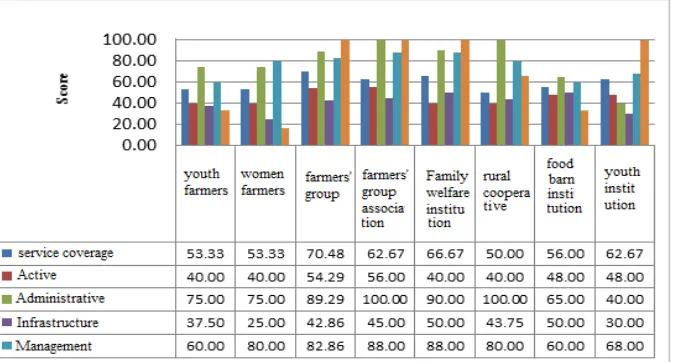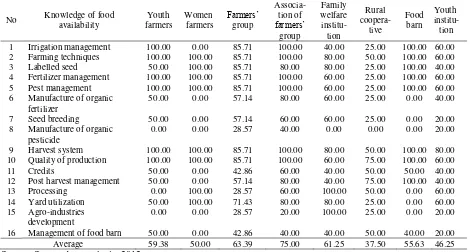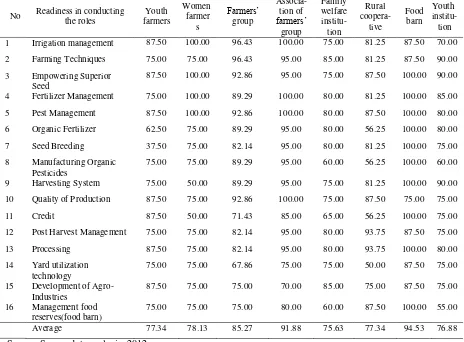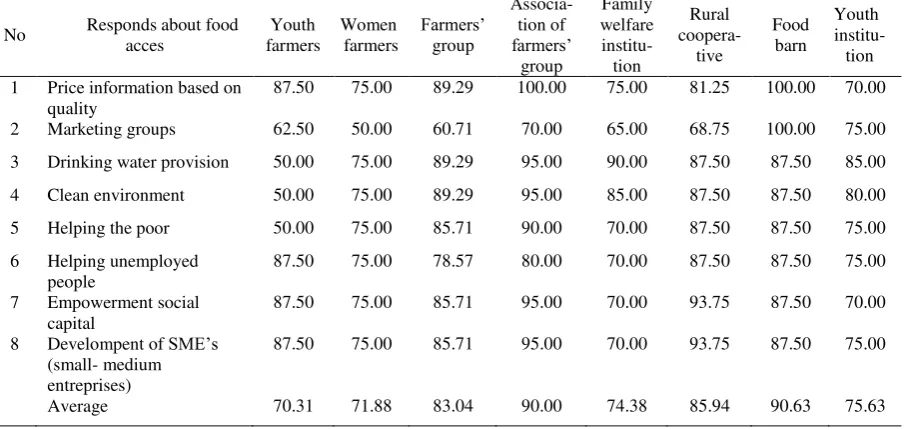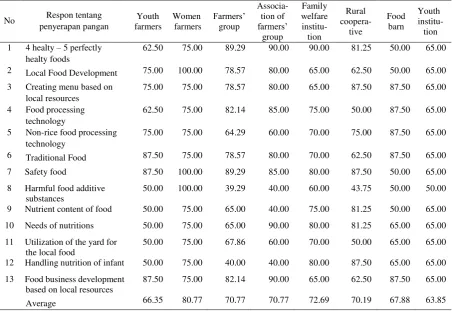THE ROLES OF RURAL INSTITUTIONS ON FOOD
SECURITY POLICY IN EAST JAVA PROVINCE
INDONESIA
Nuhfil Hanani
1, Rosihan Asmara
1, Fahriyah
1, and Sujarwo
1 1Lecturer of Department of Agricultural Economics, Faculty of Agriculture, University of Brawijaya
*corresponding author: [email protected]
ABSTRACT: This study has two main objectives, which are to identify rural institutions and their roles for supporting the implementation of food security policy in East Java Province and to formulate the model of rural institutions to enhance food security in the village level. This study was conducted on February 2012 in six regencies, which represented different food insecurity level in each locations. Primary data were collected by participatory rural appraisal method involving administrators of rural institutions. Descriptive analysis is used to describe rural institutions and their roles on food security implementation. Gap analysis is used to formulate the model to increase the roles of institutions on food security policy. It can be concluded that there are six potential rural institutions supporting food security in village level, which are women farmers’ group, farmers’ group, farmers’ group association, family welfare institution (PKK), rural cooperative, and food barn institution. Farmers’ group, farmers’ group association, and food barn institution potentially support food availability. Meanwhile, on accessibility aspect, farmers’ group, farmers’ group association, rural cooperative, and food barn institutions provide sufficient strength on this role. The last aspect on food security is food utilization. This aspect will be well supported by family welfare institution (PKK) and women farmers’ group. Finally, the institutional form in the village level fostering all aspect of food security is rural food team or TPD (Tim Pangan Desa).
Keywords: food security, local institutions, food availability, food access, food utility
INTRODUCTION
Food security is a broad concept focusing on how people can live in productive and healty life. These goals are reached from many efforts regarding how a household or a person can make the food available, accessable, and cooked properly. Therefore, the nutrients can be absorbed for having good health and getting productive life. Food availability consists of food domestic production, import, food aids, and food stocks. Moreover, food access is not only related to how the people can get the food in right amount and quality but also how the sustainability of food access can be maintained. The sustainability of food access have some influenced factors, which are physical environment, social environment, and policy environment (Riely, et al., 1999). However, human resource is significant factor fostering this security development.
This study is focusing on potential local institution supporting food security development in the rural area. The potential local institutions are observed by its roles in food availability, food access, and food utility.
Institution is defined clearly by Norman Uphoff as the complexes rules and behaviors conducted collectively that exist over time as values in the society to determine what are appropriate conducts and what are not (Uphoff, 1997). This institution definition is employed as basic definition for identifying possible rural local institution in strengthening food security.
institutions established and the goal determined, the particular function embodied in the institution, and the links of the institution internally and to different households.
This study observes about eight rural local institutions that have potential roles in enhancing rural food security. The institutions include women farmers’ institution. Quisumbing (1995) found that the role of women in household nutritions need is definitely significant and the removing constraint in women farmers from accessing resources available will greatly affect on eradicating food insecurity.
Finally, it can be stated here the important of this study as part of process in strengthening rural food security through rural local institutions.This study is also be expected to find a better model of food security institution in rural areas.
RESEARCH METHODS
The locations are taken based on food security ranking. They are two food secure regencies, two moderate food secure regencies, two food insecure regencies. The selection is based on Food Security and Vulnerability Atlas (FSVA) criteria that were issued by Food Security Council. They are Jombang, Pasuruan, Jember, Bangkalan, Sampang dan Sumenep as regency selected representing each food security level. In each sample region, one rural area will be chosen randomly. Afterward, local institutions are observed more detail using survey method.
Local institutional data are collected by participatory rural appraisal (PRA). Data collected include institutional capacity, institutional
knowledge about food and nutrition security, and response to conduct food and nutrition activities. Data Analysis
This study uses gap analysis for determining potential local institutions in developing food security in the area. Gap analysis is used to compare expectations and facts or comparing knowledge of strengthening food security (experiences) and the readiness to support food security.
The roles of each local institution in food security activities are regarding food availability, food access or distribution and consumption or food utility. The measurement of those roles is using score that represent the response of institution regarding the questions provided in the questionnaire. Finally, institutional model of of village level for enhancing food security will be proposed based on the information of local institutions’ performance and the potential function of the institution in fostering food security in the local area. This model is integrated among those potential institutions chosen and the function assigned in the institutions.
RESULTS AND DISCUSSION
The potential rural institutionsThe results from the survey found that there are eight types of institutions, which is potential for developing food security at the rural areas. There are farmers’ group, farmers’ group association, fostering family welfare institution, and youth institution. These institutions become driving force of food security development in rural areas.
Table 1. The years of institutions established
No Type of Institution Percentage number of institutions based on years established
< 2.5 2.5 – 5.0 5.0 – 7.5 7.5 – 10.0 >10
1. Youth Farmers - - - 50.00 50.00
2. Women Farmers’ group
100.00 - - - -
3. Farmers’ group 28.57 14.29 42.86 - 14.29
4. Farmers’ group association
- 60.00 20.00 - 20.00
5. Fostering family welfare institution
20.00 - 40.00 20.00 20.00
6. Rural cooperative 25.00 - 25.00 25.00 25.00
7. Food Barn institution - 50.00 - 50.00 -
8. Rural youth institution 20.00 20.00 20.00 - 40.00
The composition of existed local institutions at the study area are not the same. They are 33.3% of locations that have youth farmers, while, the other locations (66.7%) do not have youth farmers institution. Women farmers’ groups are relatively
inactive. Furthermore, the availability of food barns in the study area is only 33.3%. Although food barn has important roles to supp has difficulty in preserving and providing food for
consumption. In this sense, the area, which has no difficulties in providing food, will tend to have worse performance of food barn institution. Eventhough, the government has already set and intervene the food barn institution to secure the local food access.
Figure 2. The potential rural institutions Source: Survey, 2012
Figure 3. The activity level of rural institutionals Source: Survey, 2012
The welfare family institutions (PKK) is the most active local institution in term of the frequency of activities and rural cooperative institutions is the second one. Those two institutions are more active than the other institutions (food barn, youth farmers, and women farmers). The regular activities induced by local
The other factors considered in describing the existing of local institutions are participation and the availability of government intenvention for the institutions. For those factors, farmers’ group has the highest score in members’ participation and the existing of government intervention.
Rural institutional capacity
The indicators used for identifying the rural institutional capacity are: (1) the range of services, (2) active members, (3) administration, (4) infrastructure, and (5) management of the institution. Measurement criteria using the score from 0-100 for each indicator.
The coverage service is almost the same among those institutions observed. The plausible reason is that the location of the institutions in the village and this implies that the services tend to cover in the same area in the village.
The institutions in the village have relatively the same level of active members, which is about
40 – 56 in its score. The farmers’ group and the farmers’ group association are the better institutions regarding the active members. Those two are giving services in farming system in the rural area and the activities are relatively intensive along the years for almost all members.
There are five local institutions, which have better capacity than the others have. They are women farmers, farmers’ group, farmers’ group association, family welfare institution (PKK), and rural cooperative. Those five institutions have better quality in management, administrative. Management and administrative are two higher factors owned by those five institutions consistently. However, the institutions are in the process of being mature in organization behavior and performance. Therefore, the institutions are still depending on government interventions and struggle for having enough social capital (members participation) in order to stand in its own.
Figure 7. Summary of Potential Institutional Capacity in Rural Source: Survey, 2012
Knowledge and readiness of the local institutions in supporting rural food security
Knowledge and readiness of the local institutions to support rural food security development are measured using score of items that construct the knowledge and readiness of the institutions. The score is in interval scale of 0 to 100.
Regarding food availability, there are two institutions having better understanding and conducting activities related to food availability aspect. Those institutions are farmers’ group and farmers’ group association. The institutions are related to food producers, wausehich are farmers;
therefore, food availability is what they concern about.
Table 2. Knowledge level of rural institution of food availability 6 Manufacture of organic
fertilizer
50.00 0.00 57.14 80.00 60.00 25.00 0.00 40.00
7 Seed breeding 50.00 0.00 57.14 60.00 60.00 25.00 0.00 20.00
8 Manufacture of organic pesticide
Source: Survey data analysis, 2012
Table 3. Knowledge Level Rural Institute of Food Access
No Knowledge of food access Youth farmers
Source: Survey data analysis, 2012
Rural cooperative institution dominates the role of strengthening food access in rural area. The second institution having this potencial role is farmers’group association. Rural cooperative and farmers group association are the most potential in rural area for fostering the food access. Rural cooperative is owned by the members, which mostly are farmers. Then, the existence of this institution is going to help farmers in maintaining production and gaining benefit not only for providing available and accessible food over time but also helping farmers in accessible inputs for food production. In this perspective, rural cooperative will also be associated with farmers’ group and or farmers’ group association. The score results describe this argument firmly.
Food utility is the third aspect of food security that directly effect the nutrition intake of individual. Family welfare institution (PKK) is the higher score in knowledge about food utility comparing to the other local institutions. This makes sense since PKK consists of housewifes in the rural area, who hold decision in providing food for the entire household members.
Table 4. Knowledge level of rural institute of food utility
No Knowledge of food utility Youth farmers 1 Four healty - five perfectly
healty foods
0.00 100.00 85.71 0.00 100.00 0.00 0.00 60.00
2 Local food development 50.00 100.00 71.43 80.00 80.00 50.00 0.00 20.00 3 Creating menu based and
local resources
50.00 100.00 71.43 0.00 80.00 75.00 0.00 40.00 4 Food processing technology 50.00 0.00 57.14 80.00 60.00 50.00 0.00 0.00 5 Non-rice food processing
technology 11 Utilization of the yard for
the local food
0.00 100.00 71.43 80.00 80.00 75.00 0.00 60.00 12 Handling nutrition of infant 0.00 0.00 71.43 80.00 80.00 0.00 0.00 60.00 13 Food business development
based on local resources
50.00 100.00 57.14 60.00 80.00 0.00 100.00 40.00
Average 38.46 46.15 67.03 55.38 76.92 40.38 26.92 38.46
Source: Survey data analysis, 2012
Table 5. Readiness of local institutions in supporting food availability
No Readiness in conducting the roles
3 Empowering Superior Seed
8 Manufacturing Organic Pesticides
14 Yard utilization technology
75.00 75.00 67.86 75.00 75.00 50.00 87.50 75.00 15 Development of
Agro-Industries
87.50 75.00 75.00 70.00 85.00 75.00 87.50 75.00 16 Management food
reserves(food barn)
75.00 75.00 75.00 80.00 60.00 87.50 100.00 55.00
Average 77.34 78.13 85.27 91.88 75.63 77.34 94.53 76.88
The next analysis is observing the readiness or ability of the local institution in securing food availability role. Tables below are presenting the readiness of those eight institutions in supporting each aspect of food security in the rural area.
Analysis of the local institutions regarding food availability shows that food barn, farmers’ group and farmers’ group association have ability for strengthening this function in the rural area. Those three institutions are reasonable for fostering this function since those consist of food producers. Therefore, surplus from seasonal production can be used as a stock. Furthermore, the production at the
harvest time will fulfill the domestic food market and accessible for all people who have purchasing power in buying this food.
Food access function is imperative aspect of food security since availability will not affect in food security if the product is not accessible for all people. The distribution function finally can be assigned to the three institutions, which has ability to carry out the function of food availability, and one more potential institution that is food barn. The four institutions will potentially support in strengthening food access in rural area.
Tabel 6. Readiness of local institutions in supporting food access
No Responds about food acces 1 Price information based on
quality 6 Helping unemployed
people
87.50 75.00 78.57 80.00 70.00 87.50 87.50 75.00 7 Empowerment social
capital
Source: Survey data analysis, 2012
Food utility is the last important aspect of food security that directly affect the people health. To support this function, there are two institution potentially carrying out this role. They are women farmers’ institution and family welfare institution (PKK). Those two institutions recognize well the food utility function in the rural area. Assigning those functions for the two will potentially increase the security of food utility. It means that the rural people will increase their nutritions’ consumption for their health inline with increasing role of women farmers and PKK.
Gap Analysis
The gap is considered as the difference between what the existing of the local institutions is and what the ability or the readiness of the institution in fostering the function in food security is. The
discussion is starting what gap that institutions have in order to support food availability, food access and food utility in the rural area.
is relatively high costs; then, the sustainability of this activities (food stock locally) is very low.
The economic motive should be introduced in food barn institution and awareness on it should be built. Government plays important role in providing infrastructure, such as drying floor and the storage room.
According to the facts, the ability of food barn in village level is not feasible due to the high cost in maintaining the barn and the operation for milling the paddy. It will be feasible if there is rice milling unit and rural cooperative in the village as well. Those three agents at least, which are farers’ group, rural cooperative, and food barn institution, is needed and available in the village in order to enhance food security.
Gap in food access institutions is related to marketing as a group, helping unemployed people,
and developing off-farm and non-farm business units. There is ability or readiness to support the items in food access and as the matter of facts that the functions are not yet reached. The potential institutions regarding this role are farmers’ group association and rural cooperative.
Family welfare institution and women farmers’ group will potentially support food utility. The gap of this aspect is related to food diversification and to create the better awareness on food nutrients in the individual food consumption for productive and healty life. Moreover, food diversification is the effort of diversifying food consumption so that the people are able to reduce rice consumption and adding more kind of foodstuffs especially coming from local resources.
Tabel 7. Readiness of local institutions in supporting food utility
Source: Survey data analysis, 2012
Rural food security institution
Based on the results of the study, those indicate that the institutions handling food security in the rural areas is engaged in partial way. Therefore, it should be organized in effective coordination among the potential agents have been
identified above. Forms of organization in food security are blended of many parties in the village, which is called Rural Food Team (Tim Pangan Desa = TPD). The benefits, objectives, and the TPD function are below.
No Respon tentang 4 Food processing
technology
62.50 75.00 82.14 85.00 75.00 50.00 87.50 65.00 5 Non-rice food processing
technology 11 Utilization of the yard for
the local food
50.00 75.00 67.86 60.00 70.00 50.00 65.00 65.00 12 Handling nutrition of infant 50.00 75.00 40.00 40.00 80.00 87.50 65.00 65.00 13 Food business development
based on local resources
87.50 75.00 82.14 90.00 65.00 62.50 87.50 65.00
Benefits:
1. Increase the participation of society in the development of food security in the rural area 2. As a government means of spearheading food
security programs and activities, which can be implemented effectively and efficiently
Targets:
1. Increase the availability of food through increased production and diversification of food production both fresh and processed products 2. Increase sustainable food reserve adequacy to
address the food vulnerability in the society. 3. Increase food access to adequate food in an order
to reduce the victims of food insecurity and malnutrition
4. Improve food quality and diversification of food consumption towards improvement of nutritional status of the society.
5. Developing fresh and processed food businesses in an order to increase the value-added of food products, increasing job and incomes opportunities
Functions:
1. Planning the development of food security in rural areas
2. Instrument of transferring people asprirations to the government on the development of food security in the rural areas
3. Part of early warning system on Food and Nutrition in rural areas.
4. Implement development of food security in rural areas.
5. Encourage participation of society in the implementation of development activities of food security in rural areas
Scope of Activities
1. Increasing diversification and strengthening food production
2. Handling distribution and marketing of food products
3. Development of food reserves for society 4. Quality improvement and diversification of food
consumption
5. Improving nutritional status of children and society.
CONCLUSION
1. There are 8 kinds of potential institutions for food development institution, which consist of youth farmers’ group, women farmers’ group, farmers’ group, farmers’ group association, family welfare institution (PKK), rural cooperative, food barn, and youth institution. 2. Potential local institutions involve in food
security activities in food availability aspects are farmers group, association of farmers group, and food barn institution.
3. Potential local institutions support food access are farmers group, association of farmers group, food barn, and rural cooperative. 4. The rural institutions that will potentially
enhance food utility in rural area are women farmers’ group and family welfare institution. 5. The comprehensive forms in maintaining food
security in village level is called Rural Food Team (Tim Pangan Desa = TPD). TPD will generate all possible activities forcing mobilization of local resources toward food security development in sustainable way. TPS also has important role in connecting those six potential local institutions, i.e., women farmers’ group, farmers’ group, farmers’ group association, rural cooperative, family welfare institution, and food bran institution. , in order to achieve higher food security level in the programs. Nutrition Technical Assistance Project (FANTA), Washington, DC.
Agrawal, A. (2010). Local institutions and adaptation to climate change. Social Dimensions of Climate Change. Equity and Vulnerability in a Warming World. R. Mearns (ed.), 173-198.
Marsh, R. R. (2003). Working with local institutions to support sustainable livelihoods. Food & Agriculture Org.
Uphoff, N. T., Buck, B., & Sjorslev, J. (2006). Strengthening rural local institutional capacities for sustainable livelihoods and equitable development. World Bank.
